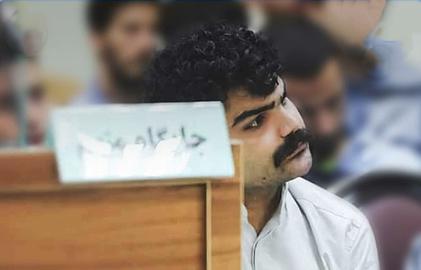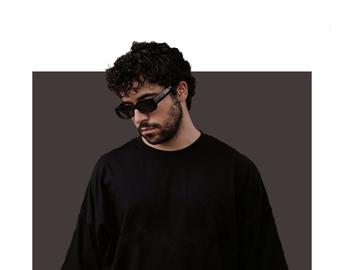Erik Burke, 37, believes that until you have a child, you really don’t understand self-sacrifice, love or what it means to stand up for something. The birth of his first child instilled in him a new resilience and belief — he says it’s something he’s willing to die for.
Describing the feeling that inspired his new mural, Burke told IranWire: “I will do anything for it. There’s going to be a lot of things out there that are going to throw shade on it, harm it, persecute it — all these things — but I will do anything to protect it.”
The mural, on the south side of the Harriet Tubman Learning Center in the heart of Harlem, depicts a child wrapped in a blanket and nestled in its mother’s arms. The mother and child, painted in a warm blue tone against a black backdrop, sleep above an exploding bouquet of orange and yellow flowers, which Burke said symbolize the shields and trophies won in battles fought to protect values — like leading a good life or the freedom to practice religion. “The Greatest Education is Your Shield and Trophy” is emblazoned across the artwork.
The painting is the fifth mural in Not A Crime’s Harlem campaign. The project aims to raise awareness about education inequality in Iran, where Baha’is are banned from teaching and studying at university. They also suffer other injustices, including executions, arbitrary arrests, arson and theft, vilification by state media and religious leaders — solely because of their religious beliefs. Fifteen murals will be painted across Harlem by the end of the summer in preparation for the United Nations General Assembly (UNGA) meeting in September, when Iran’s president, Hassan Rouhani, will be one of over 150 world leaders visiting the UN.
Burke told IranWire that his painting is meant to equate the love for his child, and the love that this mother has for her baby, with the love that Baha’is in Iran have for their faith. The flowers represent Baha’is. The flowers, nasturtiums, are commonly thought of as weeds, Burke said. He included them in the mural to show that objects sometimes thought of as ordinary, an eyesore, and even a nuisance can actually be beautiful. They have names, histories, and ancient symbolic meanings, he said.
“I like using weed plants in my art, and this one is a nasturtium. It gets its name from Latin, which is tropaeolum — it means trophy,” Burke said.
The plants were named in this way because they reminded the botanist who chose their name of an ancient Roman custom in which the victors of a battle piled up the shields and armor of the defeated army as a kind of trophy to commemorate their victory. The petals on this flower looked to the botanist like the ancient blood-stained shields, Burke said.
“You know the Baha’is, they’re weeds,” Burke said, invoking the attitude of Iran’s government toward the faith group.
“But really, no — they’re a real thing, they have a real name, they’re still a plant or they’re still a person,” he said. Burke believes that nasturtiums are the perfect objects to symbolize the hate and persecution that minority groups, such as the Baha’is in Iran, endure. “You choose to call them a weed because your ignorance won’t allow you to move past your language and your stereotyping,” he said.
Burke said that he also likes the small plants because they represent the protection of a shield, which also conjures up the love the mother has for her child as represented in his mural. “She’s protecting the little child, kind of shielding them. Also you’re really proud of them so they’re your trophy and shield.”
However, Burke’s interpretation of his art doesn’t stop there. He invites the public to comment, participate and even help him understand what he’s actually painting. “That’s what I think the cool thing about being on the street is, because people tell me what they think it is afterwards. ... That’s the nice thing about public space, the public’s input is just as valid as mine, and a lot of times they’re like, ‘That doesn’t mean that at all.’ And I’m like, ‘You’re right, I didn’t think about it that way!’”
Caroline Alexander, the Community School Director at the Learning Center, offered her own interpretation of the painting. “This is supposed to symbolize Harriet Tubman and one of her children when they were being taken for slavery,” she said. She explained that she saw the abolitionist and human rights icon in the protective way the mother is pulling the child toward her chest.
One passerby, Furard Tate, a chef from Washington DC, said of the mural, “It’s thoughtful. Education starts when you’re in your parent's arms.” He added that the flowers look like hibiscus and represented a “new beginning.”
Chekesha Rashad, a PhD candidate at the United States Sports Academy in Alabama, stopped to take photographs of the mural. “I think education is the thing that protects you from being taken advantage of. It helps you. It’s your shield when you go out into the world. Because life is a game, you’re always playing the game, and the strength of your defense is based on what you know.”
Read about the launch of the Not A Crime project in Harlem
Also read:
visit the accountability section
In this section of Iran Wire, you can contact the officials and launch your campaign for various problems


























comments